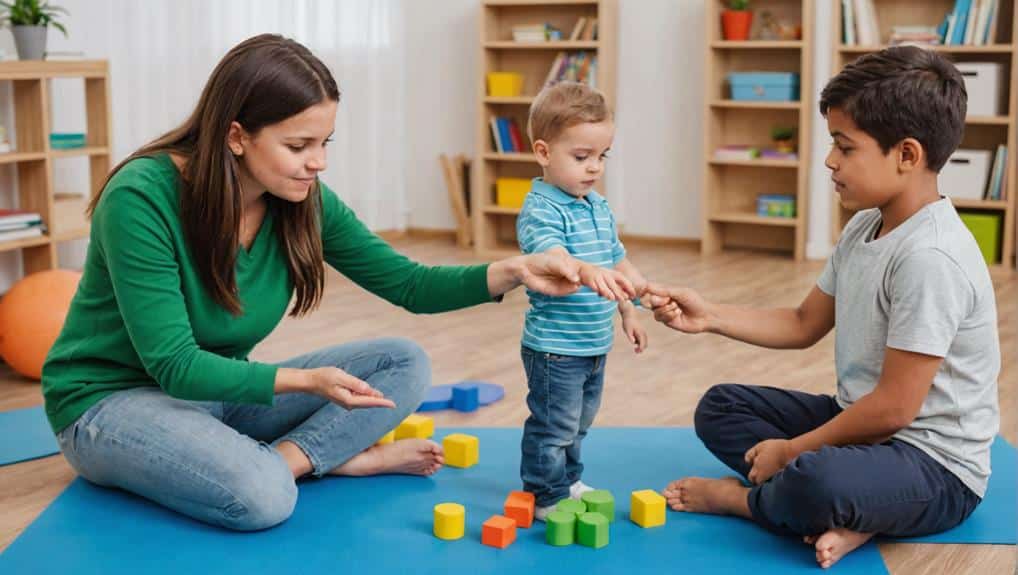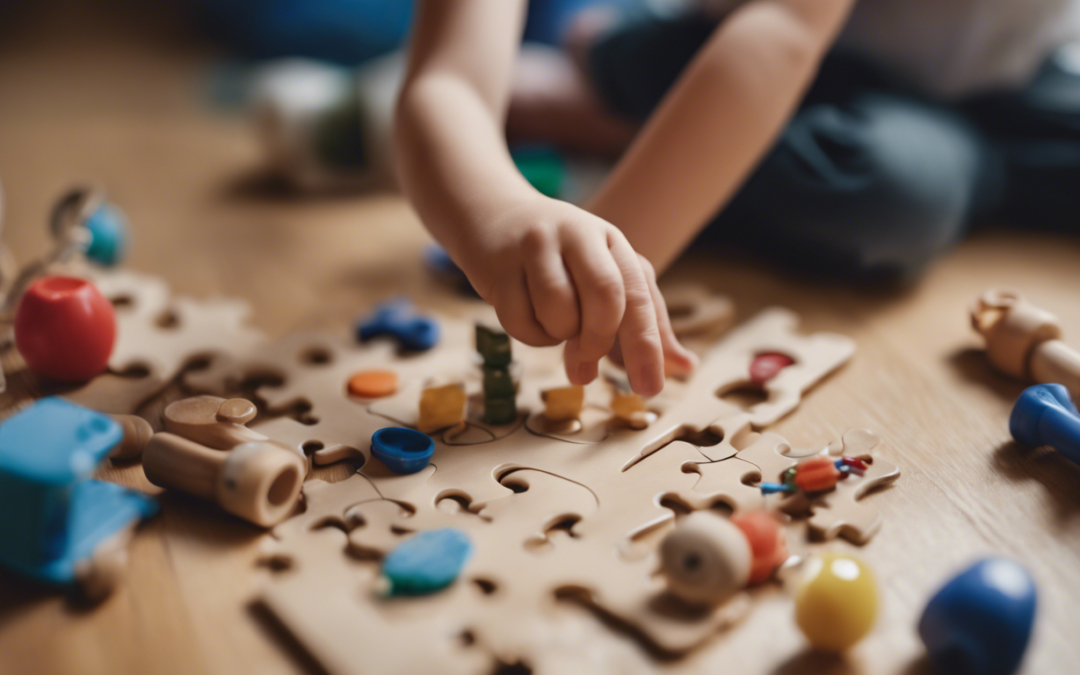Key Takeaways
- Occupational therapists employ task breakdown, sensory strategy, and fine motor skill development to enhance ADL skills.
- Occupational, speech, and physical therapy approaches target specific challenges in ADL tasks, such as fine motor skills and communication.
- Mastery of ADL tasks through therapy boosts children’s self-esteem, self-confidence, and independence.
- Implementing self-care routines and encouraging independence in children aids in overcoming ADL struggles.
- Tools like visual supports, chaining methods, and personalized strategies therapists provide are crucial in ADL training for children.
Understanding Activities of Daily Living
Understanding the concept of Activities of Daily Living (ADLs) is essential in addressing the challenges faced by children struggling with these fundamental tasks. ADLs encompass necessary daily activities such as eating, dressing, bathing, and toileting. These tasks, often taken for granted, constitute the foundation of a child’s independent functioning and self-care skills.
ADL skills are developed incrementally, with milestones typically achieved at specific stages of a child’s growth. For instance, walking is generally accomplished by 12 months, feeding by 24-30 months, and self-dressing by age 6. However, some children may struggle to master these tasks, necessitating professional help. Occupational therapists often employ sensory integration and acceptable motor skill development strategies to help overcome these difficulties and improve the child’s ADL performance.
Occupational therapy plays a significant role in this process. Occupational therapists, alongside speech-language pathologists and physical therapists, collaborate to identify and address the child’s ADL challenges. They design personalized strategies and interventions to help children improve their ADL skills and attain developmental milestones.
Recognizing and addressing ADL struggles early is essential. Beyond Boundaries Therapy Services offers free screenings and support for children with ADL difficulties, providing a supportive environment to foster their development, independence, and quality of life.
Challenges in ADL Tasks
The challenges faced by children struggling with ADL tasks often stem from underlying issues such as fine motor skills, cognitive growth, and social skills development. Occupational therapists can identify these crucial components of child development. These difficulties can profoundly impact a child’s self-esteem and sense of independence. In addressing these challenges, therapists employ practical strategies, such as task breakdown and cognitive support, to foster skill development and improve daily functioning.
Identifying Underlying Issues
Peeling back the layers of challenges in ADL tasks for children reveals the necessity of identifying underlying issues. This pivotal step in intervention paves the way for effective skill development, enabling children to master their everyday tasks. A deep understanding of sensory processing differences, motor planning challenges, and attention issues can be instrumental in addressing these struggles.
Therapists can promote self-care skills by incorporating task analysis and positive reinforcement strategies. These methods and using assistive tools and adaptive utensils can help children overcome their ADL challenges.
Occupational therapists play a pivotal role in this process. Their expertise allows them to utilize assessments effectively to pinpoint specific difficulties hindering a child’s ADL performance. The nuanced understanding they garner from these assessments helps formulate tailored strategies to overcome barriers and promote independence.
Identifying the root causes of ADL struggles is not just about immediate problem-solving. It holds the promise of long-term outcomes, leading to improved quality of life for the child. Early detection and intervention can be transformative, turning daily tasks from areas of struggle into opportunities for success. This empathetic, informed, and practical approach is needed to serve these children and help them navigate their world confidently and skillfully.
Impact on Self-Esteem
An overwhelming number of children struggling with ADL tasks often experience a significant impact on their self-worth and confidence. These challenges, particularly concerning hygiene, can pose safety concerns and affect a child’s sense of independence, further bolstering their confidence.
| ADL Challenges | Impact | Therapy Benefits |
|---|---|---|
| Difficulty in hygiene | Safety concerns, Lowered self-worth | Improves independence, Elevates confidence |
| Struggles with dressing, eating | Frustration, Low self-worth | Cultivates skills mastery, Raises self-esteem |
| Difficulty with mobility tasks | Reduced autonomy, Lowered confidence | Boosts independence, Empowers self-confidence |
| Problems managing finances | Feelings of inadequacy, Lowered self-worth | Elevates confidence, Improves life skills |
| Struggles with communication | Social isolation, Lowered self-worth | Enhances social skills, Raises confidence |
Therapy Approaches for ADL Struggles

Exploring the maze of therapy options for children struggling with Activities of Daily Living (ADL) can feel overwhelming for parents and caregivers. One of the most influential and widely used therapy approaches is occupational therapy, which employs play-based interventions to improve ADL skills in children. This treatment balances therapeutic goals and the child’s natural inclination towards play, making it an engaging and practical approach. Part of this approach can involve encouraging outdoor play, which enhances physical health and aids in mental well-being and problem-solving abilities.
Another approach is speech therapy, which focuses on improving a child’s ability to communicate and follow directions, enabling them to perform daily tasks more efficiently. It is beneficial for children whose ADL struggles include difficulties in expressing needs and understanding instructions.
On the other hand, physical therapy emphasizes physical mobility and independence in ADL tasks. It targets the child’s motor skills, lending them the physical capabilities to perform daily activities.
Building Confidence Through ADL Mastery
As parents and caregivers navigate different therapy approaches, it is vital not to lose sight of the ultimate goal: enabling the child with confidence and independence through mastery of Activities of Daily Living (ADLs). Building these skills equips children with solid self-esteem and achievement, empowering them to thrive daily.
Therapy can be a practical tool to address ADL struggles, helping children build necessary life skills and confidence. Moreover, increased independence in ADLs enriches a child’s sense of responsibility and self-efficacy. This path of self-discovery and growth through mastering ADLs fosters a solid foundation for lifelong self-confidence.
To illustrate, consider the following table:
| ADL Mastery | Benefits | Support Through Therapy |
|---|---|---|
| Grooming and Dressing | Elevates self-esteem and independence | Therapists can provide strategies and techniques |
| Eating and Cooking | Improves sense of achievement and responsibility | Therapists can guide safe and efficient practices |
| Cleaning and Organizing | Encourages confidence and autonomy | Therapists can help establish routines and systems |
Parent’s Role in ADL Development

The path to mastering Activities of Daily Living (ADL) for a child heavily involves the parents. Your role in nurturing your child’s ADL skills is essential. You provide a supportive environment where your child learns and applies these critical skills. Incorporating basic self-care routines that involve physical activities, hygiene practices, and a balanced diet can significantly improve your child’s understanding and execution of ADL tasks.
Setting routines, modeling tasks, and consistently guiding your child can help them develop autonomy, a fundamental aspect of self-care and mental wellness. Encouraging independence is another significant aspect of your role. Allow your child to engage in tasks at their own pace. Offer praise for their efforts, not just successes, to foster a positive attitude towards these activities.
Doing so will uplift their confidence and encourage emotional expression, vital to their mental health. This approach can help your child view ADL tasks as achievable, boosting their confidence and determination.
Your collaboration with therapists is invaluable. Together, you can create personalized strategies and goals for your child’s ADL development. By actively participating in therapy sessions, practicing skills at home, and reinforcing positive behaviors, you can help your child overcome ADL struggles. Remember, your involvement and commitment can significantly impact your child’s success in mastering ADL skills. Therefore, embrace your role and apply these strategies to help your child thrive.
Tools and Techniques for ADL Training
While parents play a significant role in their child’s ADL development, it’s essential to acknowledge the value of specific tools and techniques designed to assist in this process. Visual supports and task breakdowns simplify daily living skills by presenting them in manageable steps. These tools make tasks such as dressing, eating, and bathing less daunting for children who struggle with ADLs.
Sensory strategies can also be helpful. These methods aid children in processing and responding to sensory information, vital for mastering ADLs. Techniques like chaining, where tasks are broken down into sequential steps, help children understand and complete complex activities. Such strategies are often tailored to meet individual needs and abilities.
Fine motor skills are also crucial for ADL independence. Tools like puzzles and craft activities can help children develop these skills. Lastly, occupational therapists play a vital role in ADL training. They provide expert guidance and adjust techniques to meet each child’s needs, fostering independence and confidence in their daily living skills. Therefore, combining these tools and techniques offers a holistic approach to ADL training.
Overcoming ADL Struggles: Success Stories

In ADL training, triumph tales serve as guiding beacons of hope and inspiration, illustrating how children with obstacles can conquer challenges and thrive in their everyday lives. These narratives bear witness to the life-changing power of therapy interventions in enabling children to master vital life skills and gain autonomy in their daily living activities.
Here are some illustrative examples:
| Child’s Name | Challenge | Triumph Tale |
|---|---|---|
| Alex | Struggled with dressing independently | With customized strategies, Alex now dresses himself for school |
| Bella | Difficulty with eating utensils | Therapy interventions aided Bella in using utensils effectively |
| Charlie | Difficulty with personal hygiene tasks | Charlie now attends to his hygiene tasks independently |
| Daisy | Struggled with using the toilet independently | Daisy has excelled in toileting skills, enhancing her confidence |
| Ethan | Difficulty with basic chores | Ethan can now organize his room and assist with laundry |
These triumph tales underscore the significance of early intervention and tailored support. They demonstrate that with patience, perseverance, and the appropriate strategies, children with ADL challenges can overcome obstacles, nurturing a sense of self-reliance and confidence.
Frequently Asked Questions
What Is the Treatment for ADL?
The treatment for ADL struggles entails thorough ADL assessments focused on identifying challenges. Tailored interventions include ADL activities promoting progress towards set goals. Therapies provide compassionate, practical support, enhancing children’s independence in daily living tasks.
How Can Occupational Therapy Help With ADLS?
Occupational therapy aids children with ADL struggles by fostering independence through creative solutions and tailored goals. Adaptive equipment and parent involvement build confidence in mastering daily tasks and promote a higher quality of life.
How can I help my child with Children ADL Struggles at home?
To support children’s ADL struggles, break tasks into smaller, manageable steps and use visual aids or prompts. Consistency and patience are vital in building their confidence and independence.
How Can I Improve My Child’s ADL Skills?
Improving ADL skills involves engaging in skill-building activities, utilizing adaptive tools, and establishing daily routines. Incorporating visual schedules, sensory strategies, and parent involvement are critical components in enhancing these crucial life skills.
What Are the Examples of ADLS in Occupational Therapy?
Examples of ADLs in occupational therapy include dressing skills, feeding techniques, bathing routines, toileting strategies, grooming tasks, and mobility aids, all essential for a child’s functional ability and independence.
Conclusion
To sum up, while challenging, conquering ADL struggles is not impossible. Children can overcome these obstacles by utilizing tailored therapy techniques, supportive tools, and parental engagement. The achievement stories show that mastering ADL activities builds confidence, resembling the victorious narrative of scaling a rugged peak. This experience involves acquiring skills, a journey towards independence, and a strengthened sense of self-value.


Recent Comments